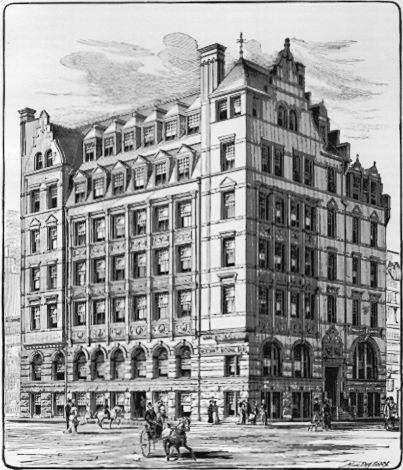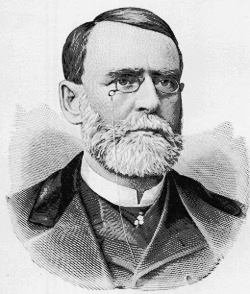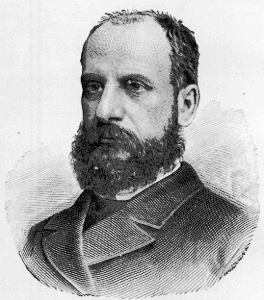|
It has
already been stated, in this brief sketch of Omaha in the
early days, that the first preacher was Rev. Peter Cooper, a
Methodist clergyman, who came over from Council Bluffs to
spread the Gospel among the pioneers. The next minister was
Rev. Isaac F. Collins, also a Methodist. Next came Rev.
William Leach, a Baptist. In September of the same year,
1855, Rev. Reuben Gaylord, a Congregationalist, visited
Omaha, and in December he brought his family here and
permanently located. The first Congregational church
building 
MERCHANTS NATIONAL BANK. erected in Omaha was a small brick structure. It is still standing, and forms a part of the large frame building now occupied as the city hall, at the northwest corner of Farnam and Sixteenth streets. The little church is attached to the rear of this building, at the northwest corner, and cannot be seen from the street. At the farewell services held in this church in 1867, preparatory to occupying other quarters, Rev. Mr. Gaylord delivered a sermon in which he gave his reminiscences covering the fourteen years he had been in Omaha. The published |
|
report of his sermon says: He commenced
preaching in the council chamber, in the old State House, in
December, 1855. There was no church organization except a
Methodist class of not more than six members. On the 4th of
May, 1856, he organized the first Congregational church in
Nebraska with nine members, and steps were taken to build a
church. The Methodists were then erecting a church on
Thirteenth street. By the 26th of October
the Congregational church was far enough advanced for services to be held in the basement. On the 9th of August, the building having been completed, the dedication sermon was preached. The Episcopalian church was the next organized, in the old State House, in 1856. An Old School Presbyterian church was formed in June, 1857, with Rev. Mr. Bergen as minister; and a New School Presbyterian church was organized in 1860." Rev. Mr. Gaylord, who died a few years ago, continued as the pastor of the Congregational church until 1864. He was succeeded by Rev. Mr. Stowell, who was followed by Rev. W. W. Rose, and Rev. E. S. Palmer. Rev. Mr. Sherrill has been the pastor of the First Congregational church since 1870. The first church edifice that was completed in Omaha was built by the Roman Catholics. It was a brick structure, on Eighth street, between Harney and Howard, and was standing until a few years ago, when it was torn down to make room for the B. & M. freight depot. The Catholic Cathedral on Ninth street was built about the year 1866. The Methodists built the second church in Omaha, in 1856, on a lot |
|||||||||
|
|
|
|

